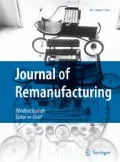Abstract
While the average life cycle of consumer goods is continuously decreasing, the amounts of used products at their end-of-life (EOL) is accumulating proportionally fast. Remanufacturing is one of the EOL strategies which is highly environmentally friendly. The selling price of remanufactured products is usually about 50—80% of a new one depending on the quality, making remanufacturing a win—win solution. The goal of this exploratory research is to present the first framework of its kind that aims at assessing the remanufacturability of office furniture. The proposed evaluation model considers three aspects of the assessment problem: economic, social and environmental to obtain a holistic view of the remanufacturability of office furniture. We apply the fuzzy TOPSIS methodology to deal with incomplete and often subjective information during the evaluation process. Furthermore, we validate our evaluation model using published research data for a multi-criteria allocation decision making (MCDM) problem. Through the validation results, we show that the proposed evaluation model has the capability to solve MCDM problems. Lastly, a case study which involves three pieces of office furniture is used to illustrate the application of the proposed model.







Similar content being viewed by others
References
Amiri MP (2010) Project selection for oil-fields development by using the AHP and fuzzy TOPSIS methods. Expert Syst Appl 37(9):6218–6224
Bulmus, S. C., Zhu, S. X. and Teunter, R., (2014), “Competition for cores in remanufacturing,” Eur. J. Oper. Res., no. 1, pp. 105–113
Chapman A, Bartlett, C., and McGill, I., (2009), “Remanufacturing in the UK: a snapshot of the UK remanufacturing industry”
Chen C-T, Lin C-T, Huang S-F (2006) A fuzzy approach for supplier evaluation and selection in supply chain management. Int J Prod Econ 102(2):289–301
Cong, L., Zhao, F., and Sunderland, J.W., (2019), A design method to improve end-of-use product value recovery for circular economy, journal of mechanical design, Vol, 141, no. 4
Ertuǧrul I, Karakaşoǧlu N (2008) Comparison of fuzzy AHP and fuzzy TOPSIS methods for facility location selection. Int J Adv Manuf Technol 39(7–8):783–795
Geissdoerfer, M., Morioka, S. N. and Carvalho, M. M., (2018), “ Business models and supply chains for the circular economy” J Clean Prod 712–721
González-García S, Gasol CM, Lozano RG, Moreira MT, Gabarrell X, Rieradevall J, Pons I, Feijoo G (2011) Assessing the global warming potential of wooden products from the furniture sector to improve their ecodesign. Sci Total Environ 410–411:16–25
Goodall P, Rosamond E, Harding J (2014) A review of the state of the art in tools and techniques used to evaluate remanufacturing feasibility. J Clean Prod 81:1–15
Hwang, L. and Yoon, K., (1981), Multiple attributes decision making methods and applications
Ilgin MA, Gupta SM (2010) Environmentally conscious manufacturing and product recovery (ECMPRO): a review of the state of the art. J Environ Manag 91(3):563–591
Jun H-B, Cusin M, Kiritsis D, Xirouchakis P (2007) A multi-objective evolutionary algorithm for EOL product recovery optimization: turbocharger case study. Int J Prod Res 45:4573–4594
Krystofik M, Liccitti A, Parnell K, Thurston M (2018) Adaptive remanufacturing for multiple life cycles: a case study in office furniture. J Resour, Conserv Recycl 135:14–35
Lindkvist, L., (2013), Exploring the use of product life- cycle information in two value chains including remanufacturing
Lund, R. T., (1985), “Remanufacturing: the experience of the United States and implications for developing countries,” World bank Tech. Pap. No.31, no. 31, pp. 1–126
Luukka P (2011) Fuzzy similarity in multicriteria decision-making problem applied to supplier evaluation and selection in supply chain management. Adv Artif Intell 2011(353509):1–9
Östlin J, Sundin J, Björkman M (2009) Product life-cycle implications for remanufacturing strategies. J Clean Prod 17(11):999–1009
Pieroni MP, Blomsma F, McAloone TC, Pigossoa CA (2018) Enabling circular strategies with different types of product/service-systems. Procedia CIRP, pp:179–184
Prendeville, S. and Bocken, N., (2016), “Design for remanufacturing and circular business models”, In M. Matsumoto, M., Masui, K., Fukushige, S. and Kondoh, S. (Eds.), Sustainability through innovations in product life cycle, pp. 269–283
Spitzley, V., Dietz, B. A. and Keoleian, G. A., (2006) “Life-Cycle Assessment of Office Furniture Products Life-Cycle Assessment of Office Furniture Products,” p. 77
Stewart, C., “5 Top Trends in the Furniture Industry,” MarketResearch.com, [Online]. Available: http://www.prnewswire.com/news-releases/marketresearchcom-5-top-trends-in-the-furniture-industry-300211661.html. [Accessed: 25-May-2016]
Sundin, E., and Lindahl, M., (2008), “Rethinking product design for remanufacturing to facilitate integrated product service offerings,” in IEEE International Symp. on Electro. and the Environ
Wang, X. and Chan, H. K., (2013), “An integrated fuzzy approach for evaluating remanufacturing alternatives of a product design,” J. Remanufacturing, vol. 3, no. 1, p. 10
Author information
Authors and Affiliations
Corresponding author
Additional information
Publisher’s note
Springer Nature remains neutral with regard to jurisdictional claims in published maps and institutional affiliations.
Appendix
Appendix
Rights and permissions
About this article
Cite this article
Otieno, W., Chen, PH. & Chen, KJ. Assessing the remanufacturability of office furniture: a multi-criteria decision making approach. Jnl Remanufactur 14, 1–16 (2024). https://doi.org/10.1007/s13243-020-00079-7
Received:
Accepted:
Published:
Issue Date:
DOI: https://doi.org/10.1007/s13243-020-00079-7




